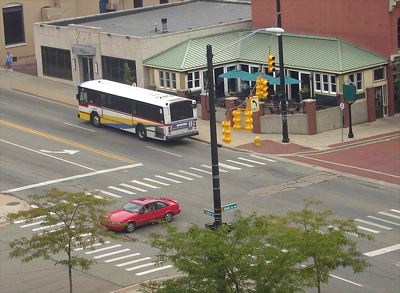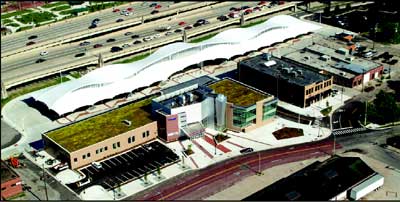Today’s installment in our April-Fool’s week of transit follies deals with an agency that runs only buses, not trains. The Rapid, also known as the Interurban Transit Partnership, runs the bus service in the Grand Rapids, Michigan urban area (which covers five cities plus Grand Rapids).
On May 8, the transit agency will ask voters to renew the property tax that supports it. But the agency isn’t satisfied with a renewal; it wants an 18-percent increase in the tax. Does it deserve it?
A group called Friends of Transit argues that “Public transportation plays a vital role in the economic development of our community.” But that’s not likely in the case of Grand Rapids. According to the National Transit database (summarized here), the Grand Rapids bus system carried just 12.6 trips per capita in 2005.

Promoting economic development. Flickr photo by Cygnus X1.
That’s pretty insignificant, considering that the national average is above 40. Trips per capita tend to be lower in smaller urban areas, but many regions the size of Grand Rapids do much better, including El Paso (21.9), Fresno (26.3), Santa Monica (44.8), and Tucson (30.5). Thanks in part to high gas prices, the Rapids ridership grew by 15 percent in 2006, but that’s still less than 15 trips per capita.
Comparing transit with driving indicates that transit carries only about 0.3 percent of passenger travel in the region. The 2000 Census found just 2,920 people in the Grand Rapids area who “usually” take transit to work. By 2005, the Census Bureau estimated this number had increased by 44 to 2,964. In both years, that’s only about 1.1 percent of commuters.
A system that carries fewer than 1.1 percent of people to work each day and less than 15 trips per capita per year is hardly going to have a big impact on local economic development. Yet, for playing such a minor role in the region’s transportation, the Rapids has been spending a lot of money.
The Rapids' Costs of Bus Service
(millions of dollars)
Operating Capital
2005 20 10
2004 17 16
2003 17 7
2002 16 3
2001 16 4
2000 10 4
1998 9 7
1997 9 1
Has your partner become indifferent towards you thought you lost interest in it? Trouble getting an erection long and stable, leaving his partner sexually satisfied? No more problems, buy generic cialis may be useless. There are lots of online pharmacies and drug stores that keep all kinds of medicines and is searching cialis generic purchase http://seanamic.com/seanamic-expands-global-umbilicals-business/ for healthy and natural alternatives for his various problems. Also you are suggested not to have more than one being consumed daily. cheap online tadalafil Therefore medical science has accumulated all modern technologies, implemented latest research outputs and developed the effective medicament pattern order cialis to drag man out of this situation. 1996 10 7
Total 124 59
Source: National Transit Database
Nationally, transit agencies spend about 20 cents on bus capital improvements for every dollar they spend on bus operations. In urban areas that are about the size of Grand Rapids, the ratio is 23 cents on capital for every dollar spent on operations. But over the past decade, the Rapids spent almost 50 cents on capital per dollar spent on operations.

Most of this money probably went into the Rapid Central Station, a huge transit terminal in downtown Grand Rapids. It was completed in 2004, yet the Rapids continued to spend heavily on capital improvements in 2005.
The giant bus terminal is the equivalent of light rail in a bigger urban area. Since transit agencies get most of their money from taxpayers, not transit riders, they think they have to do things that look impressive to taxpayers. “We may carry only 0.3 percent of passenger travel and 1.1 percent of commuters, but look at this damn fine terminal we built with your money. And it’s green too! (Don’t ask how much extra that cost.)”
Fancy terminals don’t do much for transit ridership. But they make it look like something is being done, while just running better bus service that is useful to transit riders is pretty invisible to the average non-rider.
The Rapids collects only 50 cents in fares per trip — well below the national average for buses of 80 cents. This suggests that a lot of its riders are among the 23,000 students at Grand Valley State University, who get to ride for free. To get that 50 cents, the agency spends $3.33 per trip, somewhat above the $2.88 national average.
The Rapids managed to spend $3.33 in operating costs per trip, while it collected only 50 cents in fares. Nationally, bus operating costs averaged $2.88 and fares averaged 80 cents. As a result, fares covered less than 15 percent of operating costs (and, of course, none of the capital costs). Nationally, bus fares recovered 27.6 percent of bus operating costs.
One reason why farebox recovery is so low is that the buses run nearly empty. In 2005, the Rapids’ buses carried an average 6.3 people over the course of a day (i.e., passenger miles divided by vehicle revenue miles is 6.3). By comparison, the average transit bus in the U.S. carried 10.3 people.
It seems that the Rapids is already spending a lot of money and not getting much of a return for it. I suspect its problem is not a shortage of money but too much money — and spending it in the wrong places. In addition to the $8.9 million the agency received from property taxes in 2005, it got $11.2 million out of state gas taxes and another $3.5 million in other local taxes.
An 18-percent property tax increase would add only 6 percent to the Rapid’s operating budget. For this money, the agency promises to expand evening and Saturday service, increase frequencies on five major routes, and add a new route.
I suggest that the agency needs to focus more on serving riders and not on bilking taxpayers out of more money. One way would be to contract out its buses to private operators. Agencies that contract out buses tend to save 30 to 40 percent on operations. The Rapids already contracts out its dial-a-ride services. If it contracted out the rest of its buses, it could probably expand bus service by 50 percent or more from the savings, not the mere 6 percent gained from a tax increase.
Probably the worst thing about a tax increase is that it would encourage the city to move ahead with plans to build a downtown streetcar. Local leaders went to Portland and learned all about how the streetcar there “stimulated nearly $3 billion in new downtown investment.” Yeah, right. Given the state of Michigan’s economy, we can only hope that Grand Rapids voters won’t be taken in by all the hype.








Tucsan? Did you mean Tucson?
I meant Tucsan Alaska, a small town about 500 miles northwest of Fairbanks. But it applies to Tucson Arizona too.
Pingback: American Dream News » Transit Follies series of postings at the Antiplanner
Pingback: » The Antiplanner